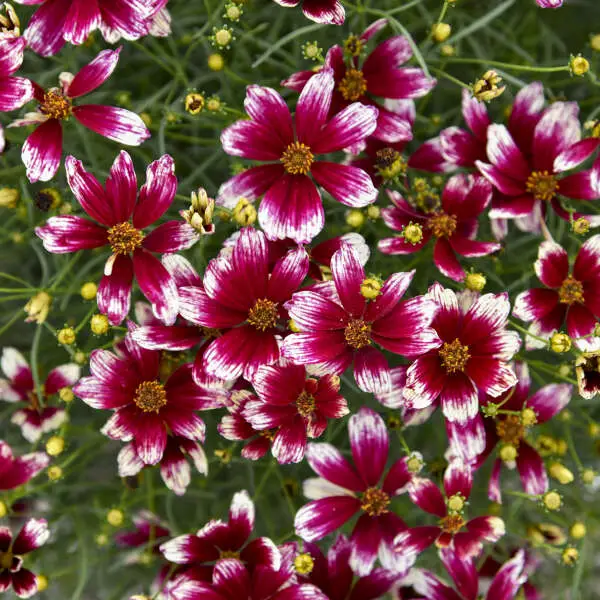Coreopsis, also known as tickseed, is a vibrant, sun-loving perennial that brightens gardens with cheerful yellow and gold blooms. Its long-lasting flowers attract pollinators and bring lively color from late spring through summer. Knowing when coreopsis bloom helps gardeners plan planting and maintenance to enjoy the full floral display.
Understanding the blooming cycle and factors that affect flower production allows you to extend the flowering season. With proper care, you can encourage more blooms, maintain plant health, and enjoy continuous color in your garden. This guide explores bloom timing, cultivation tips, and techniques to make your coreopsis thrive longer.
Understanding Coreopsis and Its Blooming Habits

Key Characteristics of Coreopsis
Coreopsis plants are hardy perennials with daisy-like flowers that come in shades of yellow, orange, red, and even bicolor patterns. Most varieties grow between 1 to 3 feet tall, with slender stems and finely divided foliage. The blooms are relatively small but appear in clusters, creating a bold and colorful display.
Coreopsis is tolerant of heat, drought, and poor soils, making it suitable for a wide range of gardens. Their resilience contributes to a long flowering season if properly maintained. Many varieties are also deer- and rabbit-resistant, ensuring minimal damage from wildlife.
Popular Coreopsis Varieties for Blooming
There are numerous coreopsis varieties, each with unique bloom periods and colors. “Early Sunrise” blooms in late spring and continues through summer. “Moonbeam” produces pale yellow flowers with long-lasting petals. “Zagreb” and “Thundercloud” are compact varieties ideal for borders and containers.
Selecting a variety suited to your climate and garden conditions can significantly impact bloom timing and duration. By choosing the right type, gardeners can enjoy a continuous display of flowers throughout the growing season.
When Do Coreopsis Bloom
Seasonal Blooming Patterns
Coreopsis typically blooms from late spring to early fall, depending on the species and local climate. In warmer regions, some varieties begin flowering as early as May, while others may continue producing flowers until October. The bloom period is influenced by sunlight, soil quality, and watering practices.
Perennial coreopsis often has multiple flushes of blooms if spent flowers are regularly removed. Annual varieties may produce a concentrated burst of flowers over a shorter period. Understanding these patterns helps gardeners schedule care for extended color.
Factors That Influence Bloom Timing
Temperature, sunlight, and soil fertility play critical roles in determining when coreopsis will bloom. Warm temperatures accelerate bud development, while cooler climates may delay flowering. Full sun is essential for optimal flower production and rich color.
Nutrient-rich, well-draining soil encourages healthy growth and abundant blooms. Overcrowding and poor airflow can reduce flowering. Adjusting these conditions ensures a more predictable and prolonged bloom period.
Techniques to Extend Coreopsis Flowering
Deadheading for Continuous Blooms
Deadheading, or removing spent flowers, is one of the most effective ways to prolong coreopsis blooms. Snip off faded flowers at the base of the stem as soon as they wilt. This redirects the plant’s energy from seed production to generating new buds, allowing multiple flowering cycles.
Consistent deadheading prevents overcrowding and maintains a neat appearance. It also reduces the risk of fungal infections by improving airflow around the plant. For perennial coreopsis, deadheading encourages blooms throughout summer and sometimes into early fall, depending on the variety and climate.
Pruning to Stimulate Growth
Light pruning stimulates bushier growth and increases flower production. Trim leggy, weak, or overcrowded stems after the first bloom cycle to promote side shoots. These side shoots often produce additional flowers, extending the flowering season.
Pruning improves sunlight penetration and air circulation within the plant, which reduces disease risk. For perennial varieties, a more substantial cutback at the end of the season rejuvenates the plant. This sets up stronger growth and larger blooms the following year. Regular pruning also helps maintain the plant’s shape and prevents sprawling, which makes the garden more visually appealing.
Fertilization and Soil Management
Balanced fertilization provides the nutrients necessary for prolonged flowering. Choose a fertilizer moderate in nitrogen to avoid excessive leafy growth. Phosphorus-rich fertilizers encourage more buds and brighter flowers.
Combine proper feeding with well-draining, nutrient-rich soil and consistent watering. Avoid waterlogged conditions, which can cause root rot, and prevent drought stress, which reduces flowering. Maintaining healthy soil ensures that coreopsis plants produce vibrant, long-lasting blooms. By combining deadheading, pruning, and fertilization, gardeners can enjoy colorful, continuous flowers well beyond the plant’s natural peak period.
Environmental Adjustments and Climate Considerations
Sunlight and Temperature Management
Coreopsis requires full sun for optimal flowering, ideally six to eight hours per day. Adequate sunlight triggers bud formation and strengthens stems, resulting in more abundant blooms. In regions with intense heat, providing light afternoon shade prevents flower wilting and leaf scorch.
Temperature also affects bloom timing and longevity. Coreopsis thrives in moderate temperatures between 20°C and 30°C. Prolonged heat can cause premature flower drop, while cooler temperatures may slow bud development. In areas with fluctuating weather, planting in microclimates with some protection from extreme heat or cold helps maintain steady bloom production.
Soil Moisture and Drainage
Proper soil conditions are essential for long-lasting flowers. Coreopsis prefers well-draining soil to prevent root rot, yet it also needs consistent moisture during active growth and flowering. Mulching around the base helps retain soil moisture, regulates temperature, and suppresses weeds.
Avoid overwatering, as excessive moisture can lead to fungal problems and weak stems. Conversely, drought stress reduces flowering and weakens plant health. Monitoring soil conditions and adjusting watering schedules according to rainfall and temperature helps maintain consistent bloom quality.
Protecting Against Environmental Stress
Wind, frost, and heavy rain can damage delicate flowers. Planting near natural windbreaks or using temporary protective covers helps shield blooms from mechanical stress. In colder climates, growing coreopsis in containers allows you to move plants indoors or to sheltered locations during frost.
By carefully managing sunlight, temperature, soil moisture, and protection from environmental stress, gardeners can maximize the flowering potential of coreopsis. These adjustments ensure brighter, longer-lasting blooms, allowing the plants to maintain their cheerful presence throughout the growing season. Proper environmental management complements pruning, deadheading, and fertilization for continuous, healthy flowering.
Seasonal Care Tips for Peak Bloom
Spring Care
Spring is the key season to prepare coreopsis for abundant flowering. Begin by removing dead or damaged stems from winter. This promotes healthy growth and allows new shoots to emerge. Check the soil and apply a balanced fertilizer to supply essential nutrients for strong stem and bud development.
Planting new coreopsis in spring ensures they establish roots before the heat of summer. Deadhead early blooms promptly to encourage continuous flower production. Mulching around the base retains moisture and suppresses weeds, supporting healthier plants. Early spring care sets the foundation for a long, vibrant flowering season.
Summer Maintenance
During summer, regular watering is essential, especially in dry regions. Coreopsis tolerates some drought, but consistent moisture encourages larger and more frequent blooms. Continue deadheading spent flowers to prevent seed formation and prolong flowering.
Light pruning may be necessary to maintain shape and remove leggy stems. Monitor for pests, such as aphids or spider mites, and treat infestations promptly using safe insecticidal solutions. Providing occasional shade during extreme heat prevents flower and leaf stress. Summer care ensures plants remain productive and vibrant.
Fall Preparation
In fall, gradually reduce watering as the plant prepares for dormancy. Perennial varieties benefit from a light trim to remove old growth, which supports healthy flowering next season. Apply a slow-release fertilizer to strengthen roots and improve winter resilience.
For potted coreopsis, move containers to protected areas if frost is expected. Mulching outdoor plants insulates roots and prolongs plant health through cooler months. Proper fall preparation ensures that coreopsis survive winter in good condition and bloom reliably the following spring.
Troubleshooting Common Blooming Problems
Bud Drop and Poor Flowering
Bud drop is a common issue that reduces the number of blooms. It often occurs due to sudden temperature changes, inconsistent watering, or insufficient sunlight. Coreopsis requires six to eight hours of direct sunlight daily to initiate and maintain bud development.
Overwatering or waterlogged soil can stress the plant, causing buds to shrivel and drop. Conversely, drought conditions limit energy available for flower production. Maintaining consistent moisture and providing well-draining soil helps prevent bud loss. Light pruning and removing crowded stems can also improve airflow, reducing stress and encouraging healthy flower formation.
Pest and Disease Management
Coreopsis can attract pests such as aphids, spider mites, and leafhoppers. Aphids cluster on new shoots, feeding on sap and weakening buds. Spider mites thrive in hot, dry conditions and cause leaf yellowing, reducing the plant’s ability to support flowers. Using neem oil, insecticidal soap, or carefully monitored chemical treatments can control infestations without harming blooms.
Fungal diseases like powdery mildew or leaf spot can develop under humid or poorly ventilated conditions. Remove affected leaves and improve spacing between plants to increase airflow. Avoid overhead watering, which can encourage fungal growth. Regular observation and early intervention prevent minor issues from severely reducing blooms.
Environmental Stress and Nutrient Deficiency
Extreme temperatures, high winds, or sudden frost can damage buds and flowers. Protect coreopsis with temporary shading, windbreaks, or moving container plants indoors. Nutrient deficiencies, particularly phosphorus shortage, can result in fewer buds and weak flowering. Applying a balanced, phosphorus-rich fertilizer during the growing season promotes more robust blooms.
By identifying the causes of bud drop, pest damage, and environmental stress, gardeners can take corrective measures. Combining proper care, nutrient management, and timely interventions ensures that coreopsis maintains abundant, vibrant flowers throughout the season.
Expert Tips for Long-Term Coreopsis Success
Maximizing Flowering Duration
To enjoy coreopsis blooms for an extended period, consistent care is essential. Regular deadheading of spent flowers encourages multiple flushes and prevents energy from diverting to seed production. Light pruning throughout the growing season helps maintain a compact plant structure, improves air circulation, and strengthens stems for more abundant flowering.
Choosing varieties with different bloom times also ensures continuous color in the garden. Early-blooming types like “Moonbeam” can be paired with later-flowering varieties such as “Zagreb” to create overlapping blooms. Planting in well-draining soil enriched with organic matter supports root health and sustained flowering throughout the season.
Soil and Fertilization Practices
Healthy, nutrient-rich soil promotes vigorous growth and prolonged flowering. Apply a balanced fertilizer high in phosphorus to stimulate bud development while avoiding excessive nitrogen, which can lead to lush foliage at the expense of blooms. Incorporate compost or organic matter annually to improve soil texture and water retention.
Regular watering during dry spells ensures steady growth, but avoid waterlogged conditions that can damage roots. Mulching helps retain moisture, control weeds, and maintain stable soil temperatures.
Managing Environmental Stress
Protect coreopsis from extreme conditions by choosing a suitable planting location. Provide partial shade during intense afternoon sun in hotter climates and use windbreaks to shield delicate stems. For potted plants, move containers indoors during frost or extreme heat.
By combining proper pruning, fertilization, soil management, and environmental care, gardeners can maximize the longevity and intensity of coreopsis blooms. Following these expert tips ensures a healthy, vibrant display year after year, keeping your garden bright, cheerful, and full of long-lasting flowers.
Propagation Techniques for Coreopsis
Coreopsis can be propagated by seeds, cuttings, or division. Seed propagation is ideal for creating many new plants or exploring new traits. Sow seeds in loose, well-draining soil, keep it consistently moist, and place it in a bright spot. Warm soil and moderate sunlight improve germination speed. Seedlings usually appear in two to three weeks, depending on the variety and conditions.
Cuttings provide a faster method to replicate favorite varieties. Select healthy stems about 10–15 cm long, remove lower leaves, and insert into moist, well-draining soil. Keep cuttings in bright, indirect light and maintain high humidity. After a few weeks, roots form, and plants can be transplanted outdoors or into larger containers.
Division works well for mature, perennial coreopsis. Gently dig up the plant, separate clumps with healthy stems and roots, and replant in prepared soil. This method not only creates new plants but also rejuvenates the parent plant, encouraging more blooms.
Applying the correct method and timing increases success rates and ensures vigorous growth. Proper care after propagation, including adequate watering, light, and nutrients, helps young plants establish quickly. Following these steps allows gardeners to expand their gardens, enjoy more flowers, and preserve the desired traits of each coreopsis variety. Propagation is an effective way to multiply plants while maintaining long-lasting, vibrant blooms.
Companion Planting and Garden Design
Coreopsis pairs beautifully with other flowers and plants. Combining it with purple, blue, or red flowers creates striking contrast and highlights its golden blooms. Low-growing plants like ornamental grasses or border flowers can surround coreopsis, providing a natural backdrop, suppressing weeds, and retaining soil moisture.
Planting coreopsis in clusters or interspersed with shrubs and perennials creates balance and a visually appealing layout. Using varieties with different bloom times ensures continuous flowering. This also attracts pollinators like bees and butterflies, improving overall plant health and bloom production.
Consider plant height and growth habit when designing the garden. Shorter coreopsis varieties suit borders and containers, while taller types can serve as centerpieces or background plants. Proper spacing prevents shading, reduces disease risk, and ensures optimal sunlight for flowering.
Regular care, including watering, fertilizing, and pruning, keeps coreopsis healthy and flowering longer. Thoughtful garden design enhances beauty, supports pollinators, and allows continuous enjoyment of vibrant blooms. Combining coreopsis with complementary plants creates a harmonious, colorful, and lively garden environment that maximizes both aesthetics and plant health.
Container Gardening for Coreopsis
Coreopsis thrives in containers, making it perfect for balconies or small spaces. Choose a pot large enough for root growth with drainage holes to prevent waterlogging. Use loose, nutrient-rich soil that drains well to encourage healthy growth and abundant blooms.
Place containers in a location receiving at least six hours of direct sunlight daily. In hot summer months, move pots to shaded areas during peak afternoon sun to prevent leaf scorch and flower drop. Containers allow better control over soil moisture and temperature, reducing stress from extreme weather.
Water consistently, especially during dry spells, and fertilize regularly with a balanced or phosphorus-rich fertilizer to promote bud development. Deadhead spent flowers to encourage continuous blooming. Container plants can also be moved indoors or to sheltered areas during frost, protecting them from cold damage.
Container gardening provides flexibility, helping maintain coreopsis health and flower longevity. This method is ideal for gardeners with limited space or harsh climate conditions. By carefully managing light, water, and nutrients, container-grown coreopsis can produce vibrant, long-lasting blooms while remaining easy to care for and highly decorative.
FAQ About When Coreopsis blooms
When do coreopsis typically start blooming?
Coreopsis usually begins flowering in late spring, around May, depending on the variety and local climate. Early-blooming types like “Moonbeam” can start slightly earlier, while late-season varieties such as “Zagreb” may bloom in mid to late summer. Adequate sunlight, consistent watering, and fertile, well-draining soil help ensure buds form on time. Monitoring temperature and protecting plants from frost or extreme heat also supports timely blooming.
How can I make coreopsis bloom longer?
To extend flowering, regularly deadhead spent flowers, removing faded blooms to encourage new bud formation. Light pruning helps maintain plant shape, improve airflow, and redirect energy to producing more flowers. Fertilize with a phosphorus-rich or balanced fertilizer every 4–6 weeks during the growing season. Consistent watering and proper sun exposure are also essential to keep plants healthy and flowering continuously.
Can coreopsis grow well in containers?
Yes, coreopsis grows very well in containers if given proper care. Choose pots with sufficient size and drainage holes to prevent waterlogging. Use nutrient-rich, well-draining soil and place containers in a sunny location receiving at least six hours of light daily. Regular watering, fertilization, and deadheading keep container plants healthy and blooming for extended periods. Containers can be moved indoors or to sheltered areas during frost or extreme heat.
What are common pests and diseases affecting coreopsis?
Common pests include aphids, spider mites, and thrips, which can damage leaves and buds. Fungal diseases such as powdery mildew or root rot may occur in overly damp or poorly ventilated conditions. To prevent issues, maintain proper spacing between plants, ensure good airflow, and avoid overwatering. Treat pests with neem oil or insecticidal soap and remove any infected leaves to reduce disease spread.
Which soil and sunlight conditions support the best blooms?
Coreopsis thrives in full sun with at least six hours of direct light daily. Well-draining soil enriched with organic matter supports healthy root development and flower production. Avoid heavy clay or poorly drained soils that can cause root rot. Consistent moisture combined with occasional fertilization ensures vibrant flowers and prolonged bloom periods. Mulching helps retain soil moisture and regulate temperature.
Conclusion
Coreopsis offers vibrant, long-lasting blooms when properly cared for. Understanding bloom timing, climate impact, and care techniques helps maximize flowering. Deadheading, pruning, and fertilization extend blooms, while propagation and container gardening expand your display. Thoughtful garden design and environmental adjustments ensure continuous color, plant health, and pollinator activity. With consistent care, coreopsis can brighten any garden from spring through fall, providing cheerful, resilient, and abundant flowers year after year.






